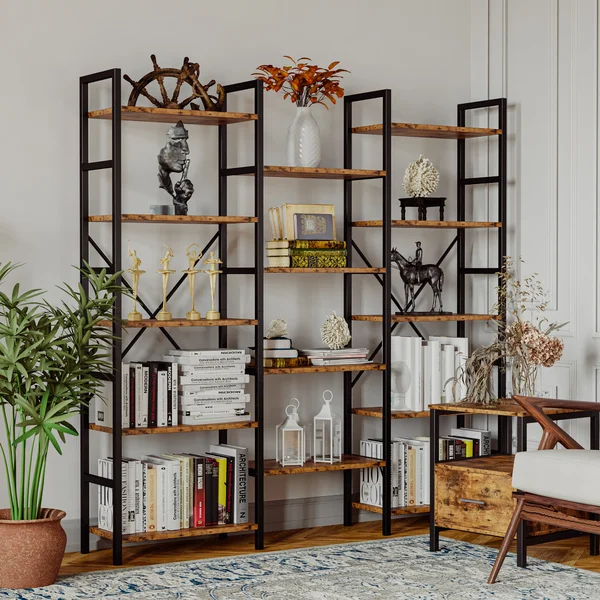Bookshelves are a great way to store your favorite reading material. They can be made from a variety of materials and can also be customized to match your personal style.
A good place to start is with a basic frame and shelves. These can be made from plywood, but you can also use repurposed wood like pallets.
Wooden
A wooden bookshelf is a stylish way to add storage and display space to your home. You can choose from a variety of wood species to create a natural look that suits your room decor. You may also want to add a clear topcoat that protects the wood from scratches and dents.
The materials used to make a custom wooden shelf can range in price depending on the size and design. For a budget-friendly option, you can choose plywood made from various layers of wood fibers that are pressed together. However, this type of wood may not be as attractive or sturdy as a walnut or pine shelf. If you’re looking for a more durable, sturdier alternative, you can consider using oak or maple plywood.
Before constructing your shelves, you should measure the width and depth of your room. This will help you determine how many shelves you need and how they should be placed.
Once you have the measurements, start by cutting the plywood into pieces that are a width that matches your bookcase’s depth. Then, take the plywood to the lumberyard and have them rip it into boards that are the depth you want for your shelves.
You can cut grooves in the plywood for a more attractive look, but it will compromise its strength. You can build a strong frame for your shelves by double-thicknessing the plywood for the sides or legs of the shelf.
You can even use a combination of metal and wood for your shelves to achieve a unique look that’s both sturdy and beautiful. This industrial pipe and wood bookshelf is a great example of this style.
Metal
Bookshelves are often used to store books, but they can also be a useful addition to any living space. They come in a variety of materials, colors and finishes to fit any style or budget. They can be free-standing or attached to the wall, so they can easily become the focal point of any room.
Some people prefer a contemporary look, while others are more traditional in their tastes. If you are looking for a bookshelf that combines style with function, consider metal frames and shelves.
You can find metal shelves in a wide variety of styles, from modern to rustic. Some of them feature open glass shelving that perfectly accents their sleek frames.
Another option is to build a bookcase that will fit inside a wall recess without a face frame. This is a quick and easy way to add storage to a wall.
Before you start, measure the depth of the recess and the width of your bookshelf. Cut the plywood to this width. Then mark the shelf lines on the board and use a framing square to transfer them to the other board.
Ripped-down plywood is easier to work with than full-sized boards, so be sure to buy pieces that are just the size you need. Next, cut the bottom shelf supports down about 3/4 inch. You’ll also need to cut a kick plate that slides under the bottom shelf.
For extra stability, a metal bar can be placed at the top and bottom of each shelf. Drill a 3/16” hole at each of these spots.
Alternatively, you can install anti-tip straps to prevent the shelf from tipping over in case of heavy weight. You can purchase a kit that comes with adhesive stickers and straps, but you will need to make sure to check them regularly for deterioration.
Glass
Whether you’re looking for a new way to organize your books or you’re just ready to add some style to your home, a glass bookshelf can help. Unlike wood or metal shelving, glass shelves allow light to pass through and make your room look more open.
If you’re planning to install a new bookshelf, it’s important to choose the right materials. Luckily, there are plenty of options to suit any budget and style preference.
One of the most popular types of shelving is glass. This material is favored by many designers for its clean aesthetics. Besides being lightweight, it’s also easy to work with.
Another benefit of a glass shelf is that it allows you to showcase your prized possessions. It can also be used to display artwork, vases, and other decor items.
When choosing a glass bookcase, it’s important to consider the size and shape of your wall space. Taller and wider bookshelves can accommodate more items than shorter, narrower ones.
It’s also worth considering your personal style and the room’s layout to decide which type of bookshelf will best fit your space. For example, if you have more floor space than wall, you should opt for a narrower shelf to maximize storage space without making the room feel smaller.
It’s also worth keeping in mind the weight of your books. A thicker glass shelf can support more weight and will be less likely to break. You can also add extra anchors to the bottom of your shelf for additional strength.
Plastic
Whether you have an abundance of books that need to be organized or are simply looking for a way to display family photos and collectibles, building a bookshelf is a great DIY project. There are many ways to build a bookshelf, and some of them are even environmentally friendly.
The first step in building a bookshelf is to determine the dimensions of the shelf unit. Decide how tall you want the finished shelf to be and how wide. This will help you figure out how much wood you need to buy.
Next, determine how many shelves you want. Standard bookshelves are usually two-, three-, four- or five-shelf units. If you’re making more than one, consider using adjustable shelving to adjust the heights of each section. This will allow you to move the shelves up or down as your needs change.
You can easily add a trim piece to the side and bottom edges of the shelves, either using molding or veneer banding. If you use veneer banding, apply it with an iron set to a low temperature.
Once you’ve covered the edges of the shelf with the trim pieces, use a router to make smooth edges. If you’d like, miter the corners of the trim pieces for a more refined look.
Most plastic shelving units are easy to assemble and can create storage space in a hurry. This makes them an ideal solution for those who work on a budget or who need fast storage solutions. They’re also perfect for use in places with frequent traffic, such as garages and warehouses. In addition, they’re often made of materials that resist scratching and denting. They are also easy to clean, so you can keep them looking new for years to come.
Rustic
Rustic home decor styles are all about natural, less polished materials that lend a sense of one-of-a-kind craftsmanship to any space. Bookshelves are an essential part of this style. They are the perfect place to store your books, as well as display art and other decor.
If you’re a DIYer who loves to build furniture, you can easily make a rustic bookshelf that adds character to your room. There are a variety of ways to build one, including using reclaimed wood or galvanized metal.
You can also build a shelving unit from wooden crates that can be used in both vertical and diagonal positions depending on the design you want to create. Simply stack the crates and secure them with a line of wood glue and a nail gun.
Once your shelves are complete, you can paint or stain them to match your decor. Just be sure to use a quality paint or stain so that the finish won’t peel off over time.
Floating shelves are another great way to add storage to your space without taking up floor space. They can be stacked to suit your needs and can easily fit into any space.
Before you start building a floating shelf, make sure to locate the wall studs and measure your board so that it will span between them. Then, attach the shelf to the wall with either drywall screws or small braces.
If you love reclaimed wood but want something more modern, consider adding a metal pipe to your shelf. This is a great DIY project that will give your space a unique industrial look with minimal effort.





